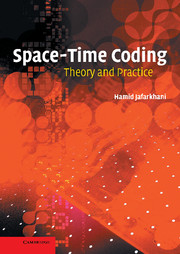Book contents
- Frontmatter
- Contents
- Preface
- Standard notation
- Space-time coding notation
- List of abbreviations
- 1 Introduction
- 2 Capacity of multiple-input multiple-output channels
- 3 Space-time code design criteria
- 4 Orthogonal space-time block codes
- 5 Quasi-orthogonal space-time block codes
- 6 Space-time trellis codes
- 7 Super-orthogonal space-time trellis codes
- 8 Differential space-time modulation
- 9 Spatial multiplexing and receiver design
- 10 Non-orthogonal space-time block codes
- 11 Additional topics in space-time coding
- References
- Index
1 - Introduction
Published online by Cambridge University Press: 14 August 2009
- Frontmatter
- Contents
- Preface
- Standard notation
- Space-time coding notation
- List of abbreviations
- 1 Introduction
- 2 Capacity of multiple-input multiple-output channels
- 3 Space-time code design criteria
- 4 Orthogonal space-time block codes
- 5 Quasi-orthogonal space-time block codes
- 6 Space-time trellis codes
- 7 Super-orthogonal space-time trellis codes
- 8 Differential space-time modulation
- 9 Spatial multiplexing and receiver design
- 10 Non-orthogonal space-time block codes
- 11 Additional topics in space-time coding
- References
- Index
Summary
Introduction to the book
Recent advances in wireless communication systems have increased the throughput over wireless channels and networks. At the same time, the reliability of wireless communication has been increased. As a result, customers use wireless systems more often. The main driving force behind wireless communication is the promise of portability, mobility, and accessibility. Although wired communication brings more stability, better performance, and higher reliability, it comes with the necessity of being restricted to a certain location or a bounded environment. Logically, people choose freedom versus confinement. Therefore, there is a natural tendency towards getting rid of wires if possible. The users are even ready to pay a reasonable price for such a trade-off. Such a price could be a lower quality, a higher risk of disconnection, or a lower throughput, as long as the overall performance is higher than some tolerable threshold. The main issue for wireless communication systems is to make the conversion from wired systems to wireless systems more reliable and if possible transparent. While freedom is the main driving force for users, the incredible number of challenges to achieve this goal is the main motivation for research in the field. In this chapter, we present some of these challenges. We study different wireless communication applications and the behavior of wireless channels in these applications. We provide different mathematical models to characterize the behavior of wireless channels. We also investigate the challenges that a wireless communication system faces.
- Type
- Chapter
- Information
- Space-Time CodingTheory and Practice, pp. 1 - 29Publisher: Cambridge University PressPrint publication year: 2005
- 2
- Cited by



